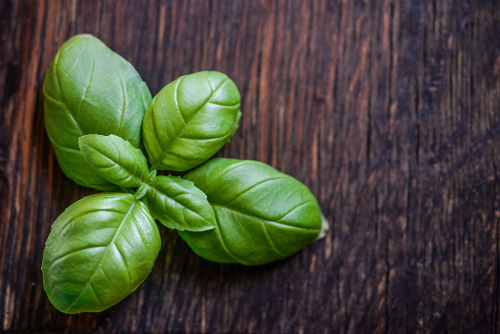Frigid, record lows (-25˚ in Dayton!), slush, freezing rain, flooding, sleet, and those sloshy, grey, black-crusted piles of old snow that are utterly depressing. Ready for summer? Sit back, close your eyes, and breathe deep. It’s August and the beat of the sun sends a waft of warm air across your bare skin. The air is comforting and tinged with a rich and sunny green aroma. Fresh basil in the garden. And tomatoes. Ah, summer. Perhaps no other herb symbolizes summer as much as basil does.
Basil’s fragrant bright green foliage adds a bushy, attractive accent to a garden and it’s said to repel certain pests of the tomato plant, as well. Grow basil in a sunny, well-drained spot (next to your tomato plants) and keep the blossoms pinched back to promote dense leaf mass. Basil can be harvested and used as soon as its leaves are big enough to suit your kitchen purposes. But gather all the basil you need before the first frost—basil is useless after even a short break of cold.
Basil and tomatoes, it seems, were created to complement each other in both the garden and the kitchen. Basil, fresh or dried, is a necessity in spaghetti and pizza sauces, and a welcome addition to any tomato recipe: tomato soup, chili, tomato salad, stuffed tomatoes, etc. Basil is also good as a leafy or slivered addition to tossed salads—simply rinse the leaves under cold water, pull the stems from the leaves, then toss them in with the rest of the salad—or, in sub sandwiches (place thin tomato slices on a roll; layer with basil leaves, cheese slices, think red onion slices; top with mayo, oil-and-vinegar salad dressing, and ground pepper; and bake open-faced at 350˚ until the cheese melts). Basil also makes a simple side of tomato slices elegant: thinly slice fresh tomatoes, layer with strips of basil, and drizzle with olive oil and red wine vinegar. Let stand for one hour before serving.
Most folks familiar with basil have a pesto recipe and ours appears below.
Basil is best used fresh from the garden, but it’s a great dried herb, too. However, basil’s intense oil content demands that it be dried in quick fashion—air drying takes too long and usually just turns the basil black and wilted. Electric dehydration or oven-drying are the best options for drying basil to its best advantage.
Basil can also be preserved in oil. Puree it in a blender with a bit of olive oil, or mince it and ad olive oil. Layer it in clean glass jars with pepper and salt, and top it with a layer of olive oil. Cover and keep the mixture refrigerated. Basil also makes a richly flavored vinegar. Crush six tablespoons of the herb and soak them in a pint or so of heated vinegar. Cover tightly and shake every two to three days. After two weeks, strain the herbs out and rebottle the vinegar.
[amd-zlrecipe-recipe:1]

